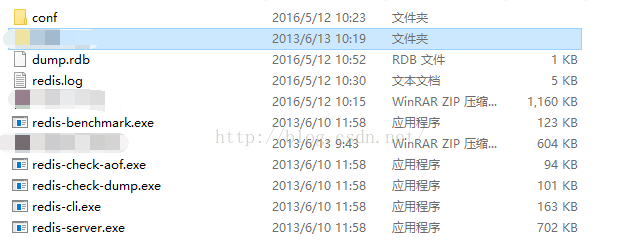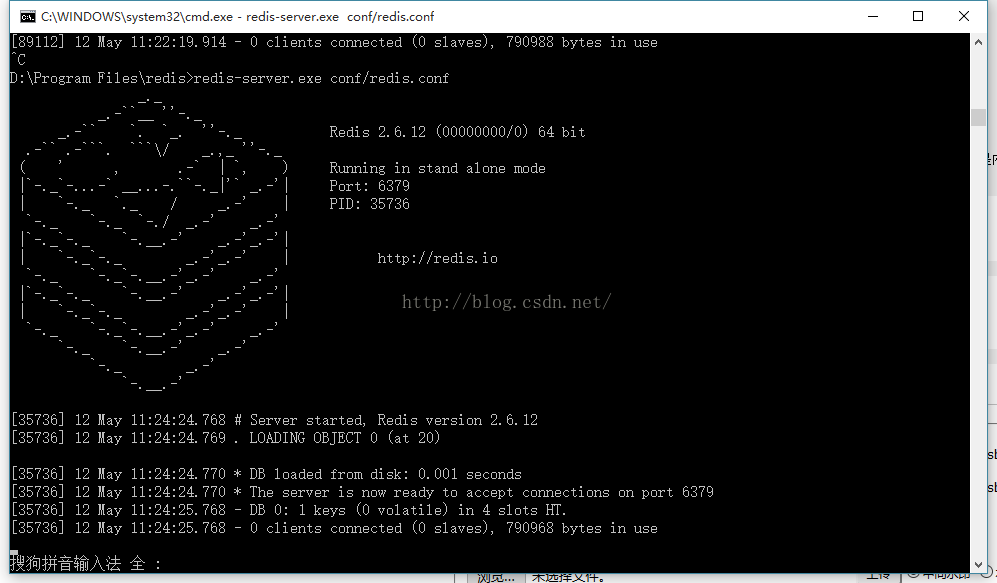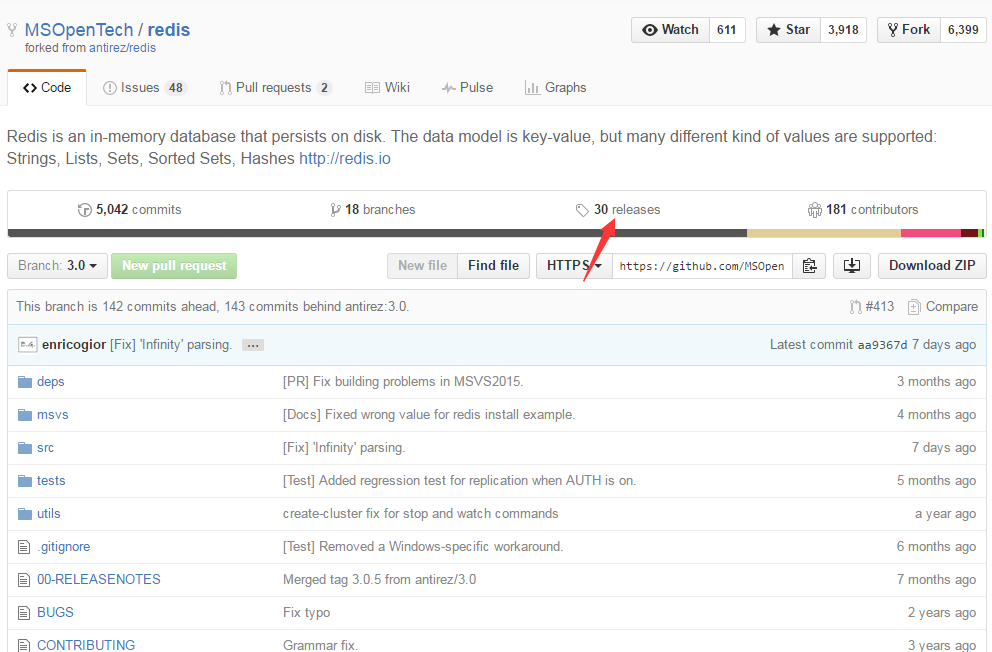Windows下Redis的安装使用教程
来源:脚本之家
2022-12-31 08:59:39
0浏览
收藏
本篇文章向大家介绍《Windows下Redis的安装使用教程》,主要包括WindowsRedis,具有一定的参考价值,需要的朋友可以参考一下。
本文主要为大家介绍缓存技术中的一种Redis的安装和使用,供大家参考,具体内容如下
一、下载Redis for windows
在网络中搜索Redis fow windows,就可以下载Redis的压缩包。解压包。

会发现其中有32位和64位的不同版本的包,根据需要,使用对应的压缩包即可。
二、解压
我使用的是redisbin_x64.zip的压缩包,将其解压到redis的文件夹中。

解压之后,会发现内容只有一些.exe的文件。到这里,redis就算做好了一半了。
三、配置
在redis下新建一个conf的文件夹,并创建 redis.conf 文本文件。将一下内容复制到配置文件中。
# Redis configuration file example # By default Redis does not run as a daemon. Use 'yes' if you need it. # Note that Redis will write a pid file in /var/run/redis.pid when daemonized. # 是否以后台进程的形式运行,默认为no daemonize no # When run as a daemon, Redis write a pid file in /var/run/redis.pid by default. # You can specify a custom pid file location here. # 如果指定以后台形式执行,则需要指定一个pid文件 pidfile /var/run/redis.pid # Accept connections on the specified port, default is 6379 #监听端口号 port 6379 # If you want you can bind a single interface, if the bind option is not # specified all the interfaces will listen for connections. # 绑定主机IP # bind 127.0.0.1 # Close the connection after a client is idle for N seconds (0 to disable) # 客户端空闲超时时间,设置为0,则没有超时。过了空闲时间,则会将客户端的连接关闭 timeout 300 # Set server verbosity to 'debug' # it can be one of: # debug (a lot of information, useful for development/testing) # notice (moderately verbose, what you want in production probably) # warning (only very important / critical messages are logged) # 日志记录等级 loglevel debug # Specify the log file name. Also 'stdout' can be used to force # the demon to log on the standard output. Note that if you use standard # output for logging but daemonize, logs will be sent to /dev/null # 日志记录方式 logfile stdout # Set the number of databases. The default database is DB 0, you can select # a different one on a per-connection basis using SELECT <dbid> where # dbid is a number between 0 and 'databases'-1 # 可用数据库数目 databases 16 ################################ SNAPSHOTTING ################################# # # Save the DB on disk: # # save <seconds><changes> # # Will save the DB if both the given number of seconds and the given # number of write operations against the DB occurred. # # In the example below the behaviour will be to save: # after 900 sec (15 min) if at least 1 key changed # after 300 sec (5 min) if at least 10 keys changed # after 60 sec if at least 10000 keys changed save 900 1 save 300 10 save 60 10000 # Compress string objects using LZF when dump .rdb databases? # For default that's set to 'yes' as it's almost always a win. # If you want to save some CPU in the saving child set it to 'no' but # the dataset will likely be bigger if you have compressible values or keys. # 存储到本地数据库时,是否需要压缩数据 rdbcompression yes # The filename where to dump the DB #本地数据名称 dbfilename dump.rdb # For default save/load DB in/from the working directory # Note that you must specify a directory not a file name. # 本地数据库存放路径 dir ./ ################################# REPLICATION ################################# # Master-Slave replication. Use slaveof to make a Redis instance a copy of # another Redis server. Note that the configuration is local to the slave # so for example it is possible to configure the slave to save the DB with a # different interval, or to listen to another port, and so on. # 当该服务为从服务时,设置主服务的ip地址和端口号 # # slaveof <masterip><masterport> # If the master is password protected (using the "requirepass" configuration # directive below) it is possible to tell the slave to authenticate before # starting the replication synchronization process, otherwise the master will # refuse the slave request. # 当该服务为从服务时,设置主服务的连接密码 # # masterauth <master-password> ################################## SECURITY ################################### # Require clients to issue AUTH <password> before processing any other # commands. This might be useful in environments in which you do not trust # others with access to the host running redis-server. # # This should stay commented out for backward compatibility and because most # people do not need auth (e.g. they run their own servers). # 连接密码 # # requirepass foobared ################################### LIMITS #################################### # Set the max number of connected clients at the same time. By default there # is no limit, and it's up to the number of file descriptors the Redis process # is able to open. The special value '0' means no limts. # Once the limit is reached Redis will close all the new connections sending # an error 'max number of clients reached'. # 最大客户端连接数,默认不设置 # # maxclients 128 # Don't use more memory than the specified amount of bytes. # When the memory limit is reached Redis will try to remove keys with an # EXPIRE set. It will try to start freeing keys that are going to expire # in little time and preserve keys with a longer time to live. # Redis will also try to remove objects from free lists if possible. # # If all this fails, Redis will start to reply with errors to commands # that will use more memory, like SET, LPUSH, and so on, and will continue # to reply to most read-only commands like GET. # # WARNING: maxmemory can be a good idea mainly if you want to use Redis as a # 'state' server or cache, not as a real DB. When Redis is used as a real # database the memory usage will grow over the weeks, it will be obvious if # it is going to use too much memory in the long run, and you'll have the time # to upgrade. With maxmemory after the limit is reached you'll start to get # errors for write operations, and this may even lead to DB inconsistency. # 设置最大内存,达到最大内存设置后,Redis线尝试清楚已到期或即将到期的key,当此方法处理后,达到最大内存设置,将不能在进行写入操作。 # # maxmemory <bytes> ############################## APPEND ONLY MODE ############################### # By default Redis asynchronously dumps the dataset on disk. If you can live # with the idea that the latest records will be lost if something like a crash # happens this is the preferred way to run Redis. If instead you care a lot # about your data and don't want to that a single record can get lost you should # enable the append only mode: when this mode is enabled Redis will append # every write operation received in the file appendonly.log. This file will # be read on startup in order to rebuild the full dataset in memory. # # Note that you can have both the async dumps and the append only file if you # like (you have to comment the "save" statements above to disable the dumps). # Still if append only mode is enabled Redis will load the data from the # log file at startup ignoring the dump.rdb file. # # The name of the append only file is "appendonly.log" # # IMPORTANT: Check the BGREWRITEAOF to check how to rewrite the append # log file in background when it gets too big. # 设置Redis服务器在每次操作完成后,是否更新日志操作,如果关闭,可能会在断电时导致一段时间内的数据丢失, # 因为Redis本身同步数据文件是按照上面的save条件来同步的,所以有的数据会在一段时间内存储于内存中。 appendonly no # 更新日志文件名 # appendfilename appendonly.aof # The fsync() call tells the Operating System to actually write data on disk # instead to wait for more data in the output buffer. Some OS will really flush # data on disk, some other OS will just try to do it ASAP. # # Redis supports three different modes: # # no: don't fsync, just let the OS flush the data when it wants. Faster. # always: fsync after every write to the append only log . Slow, Safest. # everysec: fsync only if one second passed since the last fsync. Compromise. # # The default is "always" that's the safer of the options. It's up to you to # understand if you can relax this to "everysec" that will fsync every second # or to "no" that will let the operating system flush the output buffer when # it want, for better performances (but if you can live with the idea of # some data loss consider the default persistence mode that's snapshotting). # 更新日志条件,有三个可选值: appendfsync always # appendfsync everysec # appendfsync no ############################### ADVANCED CONFIG ############################### # Glue small output buffers together in order to send small replies in a # single TCP packet. Uses a bit more CPU but most of the times it is a win # in terms of number of queries per second. Use 'yes' if unsure. #glueoutputbuf yes # Use object sharing. Can save a lot of memory if you have many common # string in your dataset, but performs lookups against the shared objects # pool so it uses more CPU and can be a bit slower. Usually it's a good # idea. # # When object sharing is enabled (shareobjects yes) you can use # shareobjectspoolsize to control the size of the pool used in order to try # object sharing. A bigger pool size will lead to better sharing capabilities. # In general you want this value to be at least the double of the number of # very common strings you have in your dataset. # # WARNING: object sharing is experimental, don't enable this feature # in production before of Redis 1.0-stable. Still please try this feature in # your development environment so that we can test it better. # shareobjects no # shareobjectspoolsize 1024 # 是否使用虚拟内存 #vm-enabled no; # 虚拟内存文件路径,不能多个redis共享 # vm-swap-file /tmp/redis.swap # 将所有大于vm-max-memory 的数据存入虚拟内存。无论vm-max-memory值大小,所有的索引数据都是内存数据。 # 如果将vm-max-memory设置为0,则所有的数据都存放在磁盘。 # vm-max-memory 0 </bytes></password></master-password></masterport></masterip></changes></seconds></dbid>
四、启动redis服务器
使用一下命令启动 redis服务器。
redis-server.exe conf/redis.conf
启动成功之后,你会看到如下的提示:

五、连接redis服务器
使用redis自带的命令,能够连接服务器。
redis-cli.exe -h localhost -p 6379
连接成功之后,会提示以下内容:

这个时候,你就能够使用redis的一下指令操作数据。其他指令,请在网上具体查看一下。
以上就是本文的全部内容,希望对大家的学习有所帮助。
理论要掌握,实操不能落!以上关于《Windows下Redis的安装使用教程》的详细介绍,大家都掌握了吧!如果想要继续提升自己的能力,那么就来关注golang学习网公众号吧!
版本声明
本文转载于:脚本之家 如有侵犯,请联系study_golang@163.com删除
 CentOS系统中Redis数据库的安装配置指南
CentOS系统中Redis数据库的安装配置指南
- 上一篇
- CentOS系统中Redis数据库的安装配置指南

- 下一篇
- win 7 安装redis服务【笔记】
查看更多
最新文章
-

- 数据库 · Redis | 5小时前 |
- 监控Redis集群健康状态的工具与指标
- 112浏览 收藏
-

- 数据库 · Redis | 1星期前 |
- Redis数据安全防护全攻略
- 252浏览 收藏
-

- 数据库 · Redis | 2星期前 |
- Redis主从复制故障排查与修复技巧
- 302浏览 收藏
-

- 数据库 · Redis | 2星期前 |
- Redis与HBase存储方案详解
- 325浏览 收藏
-

- 数据库 · Redis | 2星期前 |
- Redis数据安全防护全攻略
- 157浏览 收藏
-

- 数据库 · Redis | 2星期前 |
- 高并发Redis优化技巧分享
- 257浏览 收藏
-

- 数据库 · Redis | 2星期前 |
- Redis数据安全防护全攻略
- 398浏览 收藏
-

- 数据库 · Redis | 3星期前 |
- Redis配置加密方法与安全设置
- 232浏览 收藏
-

- 数据库 · Redis | 3星期前 |
- RedisHyperLogLog高效统计技巧
- 283浏览 收藏
-

- 数据库 · Redis | 3星期前 |
- Redis与MySQL缓存同步方法详解
- 141浏览 收藏
-

- 数据库 · Redis | 3星期前 |
- Redis布隆过滤器防穿透原理解析
- 312浏览 收藏
-

- 数据库 · Redis | 1个月前 |
- Redis容器化部署实战技巧分享
- 195浏览 收藏
查看更多
课程推荐
-

- 前端进阶之JavaScript设计模式
- 设计模式是开发人员在软件开发过程中面临一般问题时的解决方案,代表了最佳的实践。本课程的主打内容包括JS常见设计模式以及具体应用场景,打造一站式知识长龙服务,适合有JS基础的同学学习。
- 543次学习
-

- GO语言核心编程课程
- 本课程采用真实案例,全面具体可落地,从理论到实践,一步一步将GO核心编程技术、编程思想、底层实现融会贯通,使学习者贴近时代脉搏,做IT互联网时代的弄潮儿。
- 516次学习
-

- 简单聊聊mysql8与网络通信
- 如有问题加微信:Le-studyg;在课程中,我们将首先介绍MySQL8的新特性,包括性能优化、安全增强、新数据类型等,帮助学生快速熟悉MySQL8的最新功能。接着,我们将深入解析MySQL的网络通信机制,包括协议、连接管理、数据传输等,让
- 500次学习
-

- JavaScript正则表达式基础与实战
- 在任何一门编程语言中,正则表达式,都是一项重要的知识,它提供了高效的字符串匹配与捕获机制,可以极大的简化程序设计。
- 487次学习
-

- 从零制作响应式网站—Grid布局
- 本系列教程将展示从零制作一个假想的网络科技公司官网,分为导航,轮播,关于我们,成功案例,服务流程,团队介绍,数据部分,公司动态,底部信息等内容区块。网站整体采用CSSGrid布局,支持响应式,有流畅过渡和展现动画。
- 485次学习
查看更多
AI推荐
-

- ChatExcel酷表
- ChatExcel酷表是由北京大学团队打造的Excel聊天机器人,用自然语言操控表格,简化数据处理,告别繁琐操作,提升工作效率!适用于学生、上班族及政府人员。
- 3162次使用
-

- Any绘本
- 探索Any绘本(anypicturebook.com/zh),一款开源免费的AI绘本创作工具,基于Google Gemini与Flux AI模型,让您轻松创作个性化绘本。适用于家庭、教育、创作等多种场景,零门槛,高自由度,技术透明,本地可控。
- 3375次使用
-

- 可赞AI
- 可赞AI,AI驱动的办公可视化智能工具,助您轻松实现文本与可视化元素高效转化。无论是智能文档生成、多格式文本解析,还是一键生成专业图表、脑图、知识卡片,可赞AI都能让信息处理更清晰高效。覆盖数据汇报、会议纪要、内容营销等全场景,大幅提升办公效率,降低专业门槛,是您提升工作效率的得力助手。
- 3403次使用
-

- 星月写作
- 星月写作是国内首款聚焦中文网络小说创作的AI辅助工具,解决网文作者从构思到变现的全流程痛点。AI扫榜、专属模板、全链路适配,助力新人快速上手,资深作者效率倍增。
- 4506次使用
-

- MagicLight
- MagicLight.ai是全球首款叙事驱动型AI动画视频创作平台,专注于解决从故事想法到完整动画的全流程痛点。它通过自研AI模型,保障角色、风格、场景高度一致性,让零动画经验者也能高效产出专业级叙事内容。广泛适用于独立创作者、动画工作室、教育机构及企业营销,助您轻松实现创意落地与商业化。
- 3784次使用
查看更多
相关文章
-
- Windows下Redis x64的安装与使用教程详解
- 2022-12-31 269浏览
-
- Windows中Redis安装配置流程并实现远程访问功能
- 2022-12-30 120浏览
-
- Windows下redis下载、redis安装及使用教程
- 2022-12-31 201浏览
-
- WINDOWS中REDIS主从配置实现代码解析
- 2022-12-30 423浏览
-
- windows 64位下redis安装教程
- 2022-12-30 203浏览



